End of an Era
After nearly two decades leading Rice, David Leebron leaves behind a school transformed.
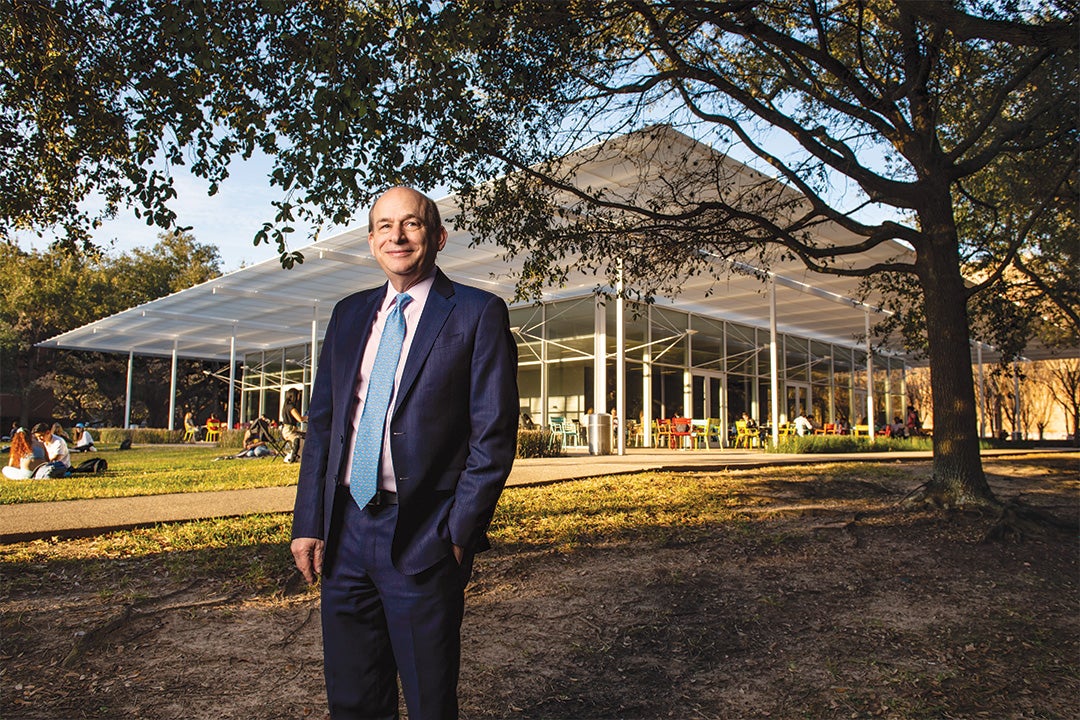
By Schaefer Edwards '13
In the middle of Rice’s live oak-lined campus, situated near warm brick buildings with ruddy tiled roofs, sits Brochstein Pavilion, a bright white metal and glass-walled café and popular gathering spot for the campus community. On any given day, students, faculty, staff and visitors fill the tables inside and out, huddled in conversation, catching up over coffee, keyboards clattering away.
Completed just three years into President David Leebron’s 18-year tenure leading Rice, Brochstein became an early proof of concept for his hypothesis that the university could find a sweet spot between tradition and modernity.
“The thing about Brochstein is it didn’t replace anything: It created something new,” Leebron said during a series of recent interviews reflecting on his time at Rice. “It was both a bold piece of architecture for the campus, but at the same time fit in beautifully with the campus. … We want to preserve the beauty and consistency of our campus in many respects, but also wanted some buildings that reflected the very highest aspirations of architecture.” Its modern design speaks to Leebron’s view that Rice could stay Rice while striking out toward an ambitious vision for the future.
Nearly two decades after leaving his position as dean of Columbia University’s School of Law, Leebron announced in May 2021 that this academic year would be his last.
When asked how he hopes his presidency will be remembered, Leebron demurred. “It’s hard not to be immodest in answering that question. One thing would be just to not answer it,” he quipped.
Steering the Ship
Unlike many other historic institutions and larger universities, “the great thing about Rice,” Leebron said, “is that it’s a ship that can be turned. You can have an impact on things, and people want to help you in many ways.” And turn the ship he has, by embracing a strategy of thoughtful expansion across all aspects of Rice’s teaching, research and engagement missions.
“David never hesitated to explore bold opportunities, but ultimately always made decisions that were best for our university,” wrote Rice Board of Trustees Chairman Rob Ladd ’78, heralding Leebron’s many accomplishments in a message to the Rice community.
Leebron spearheaded the ambitious plan that grew Rice’s student body of 4,855 by nearly 70% from 2004 to 2021 and began implementation of an expansion to 9,000 students by 2025. Under Leebron’s tenure, Rice also reaffirmed its commitment to the residential college system with two new colleges — McMurtry and Duncan — opening in 2009, and a 12th college in the works. Indeed, the campus has transformed through $1.8 billion in investments, with some projects, like the Moody Center for Student Life and Opportunity, the new science and engineering building, and Sarofim Hall for Visual and Dramatic Arts, still underway.
Through strategic partnerships and investments, he helped significantly increase Rice’s visibility across the globe; now, nearly a quarter of all Rice students hail from outside the United States. He also prioritized Rice’s commitment to research — going from $73.9 million in external research awards in his first year to $181.9 million in 2021.
“He’s a relentless thinker and doer,” said James Crownover ’65, former Rice Board of Trustees chairman and leader of the presidential search committee that wooed Leebron and his family — wife Ping Sun, an attorney, and their children Daniel and Mei — to head for the Lone Star State.
I’m a huge fan. I think that he’s been the most transformative and consequential president since we were founded, since [Edgar Odell] Lovett.
Leebron has worked to trim Rice’s tall hedges, leading the effort to harness the Rice community’s scholarly resources and students’ passion for activism. Due to concerted efforts to increase Rice’s international ties and the groundbreaking Rice Investment financial aid plan that’s helped make a Rice education more affordable and financial aid much more transparent, the university has become a more diverse, inclusive institution over the past 18 years.
None of these achievements would have been possible were it not for a strong fundraising ecosystem. Leebron launched two major fundraising campaigns that brought in over $2.5 billion to finance plans for Rice’s physical and human growth, even as a national financial crisis threatened to cause major cutbacks and get in the way of growing the school’s endowment.
“I’m a huge fan,” said Annise Parker ’78, former mayor of Houston. “I think that he’s been the most transformative and consequential president since we were founded, since [Edgar Odell] Lovett.”
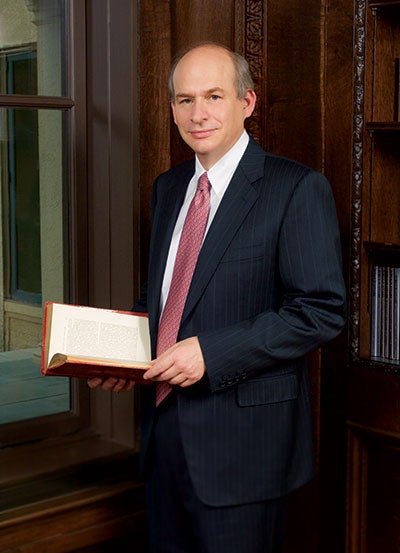
Good Enough?
Before Leebron was hired, many referenced a creeping sense of complacency at the university, a feeling that it would be fine if Rice remained a top-notch, regionally lauded institution, hidden from the city behind the hedges.
“Rice was, I thought, in danger of imploding,” said Terrence Doody, Rice English professor emeritus. “It was going to collapse into itself, build and build the barriers. Its attitude was, ‘Well, we’re Rice! We’re still in the top 20, we have great students, we’re very rich. We don’t have to do a single thing.’
“He was not like that. … He just expanded its vision in extraordinary ways,” Doody said of Leebron.
Leebron, too, noticed a similar air of complacency when he arrived. “One way it manifested was people were resistant to comparing us to other universities, that setting those comparisons and those standards would damage our uniqueness. And I think you can look at other universities and compare and set aspirations and still say, ‘What’s unique about us? What do we want to maintain?’”
Once on campus, the new president established himself as a gifted and witty orator, both friendly and approachable with students. He embarked on a listening tour, seeking input on every side of issues of importance to Rice students, alumni, trustees, faculty and other Houston leaders.
An early question arose centered around the fact that Rice was a school trying to excel in a plethora of areas that belied its size.
“One of the decisions to be made at a small university with a broad agenda is should we narrow our agenda? Or should we grow the university, or should we do neither? And David’s choice there was actually to grow the university, but not narrow the agenda,” said Bobby Tudor ’82, former Rice board chairman. “I think it’s proven to be the right choice … it really did define his presidency.”
Once expanding the student body was made a top priority, some worried expansion might mean shifting away from residential colleges. Leebron admitted the thought crossed his mind, if only for a moment — “I said to some folks, ‘I’m a lawyer. We’re going to ask all the questions. We’re going to explore things.’ Now, do I think it would have been unbelievably stupid to move away from the college system? Yes!” he said emphatically.
Another uniquely Rice trait Leebron knew needed preserving was the warm student community that fostered collaboration over competition, something many peer institutions can’t claim. “I don’t hear that they think that other people’s successes are at their expense in some way. Those are things that are important not to break,” Leebron said.
Mikki Hebl, Rice’s Martha and Henry Malcolm Lovett Chair of Psychological Sciences, described Leebron as “a great protector” of the university. “I realize these are never one-person shows,” she said, “but David has made some tough, very scrutinized decisions, and the world has watched and commended us at Rice.”
Despite some pushback, Leebron was convinced that Rice had to grow to achieve the full breadth of its ambitions, and that it could while keeping its culture intact. There might be some hiccups, but it was a risk worth taking.
“If you think everything’s got to go perfectly, you’ll never do anything,” Leebron said.
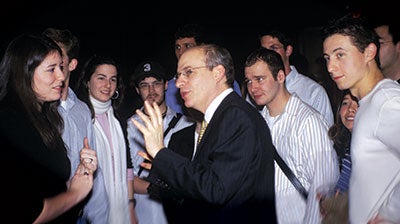
Let Rice Shine
When Leebron brought Linda Thrane on board to lead Rice’s Office of Public Affairs early in his presidency, he gave her one key charge: “He had decided that keeping Rice’s light under a basket was not a good strategy,” said Thrane. “So, it was my job to shine that light as far and as wide as I could.”
One aspect of achieving that goal was strengthening Rice’s ties to the city of Houston. “The hedges may as well have been a wall,” explained Parker, a Greater Houston native.
The Vision for the Second Century — the strategic plan devised by Leebron’s team in 2005 — explicitly called out the need for Rice to more directly engage with the city of Houston. That presaged the Passport to Houston program, which enticed students to venture into the city with free public transportation and free or reduced admission to museums, performances and more. The plan also set the stage for the creation of the BioSciences Research Collaborative, signaling a new era of collaboration between Rice and the Texas Medical Center. “David realized there was so much more we could accomplish together,” said Yousif Shamoo, Rice’s former vice provost for research and the Ralph and Dorothy Looney Professor of BioSciences.
Parker recalled a unique partnership during the Leebron era involving a cadre of civic-minded applied math students. “My team assigned them, of all things, to work at BARC,” the city-run animal shelter and one of Parker’s passion projects. The students “did some amazing work” analyzing BARC’s live animal release rates compared to other major cities, among other initiatives.
“To be able to benefit from the horsepower of Rice math nerds working on a real-world city problem was phenomenal,” Parker said of just one of many times over the past 18 years that Houston has been served by Rice students, who gained real-world problem-solving experience along the way.
Rice’s expanded engagement with the city and region was turbocharged when the Kinder Institute for Urban Research was launched in 2010. Leebron credits the institute’s research, surveys and policy work for “perhaps being the best example” of how Rice has become “a force within the city.”
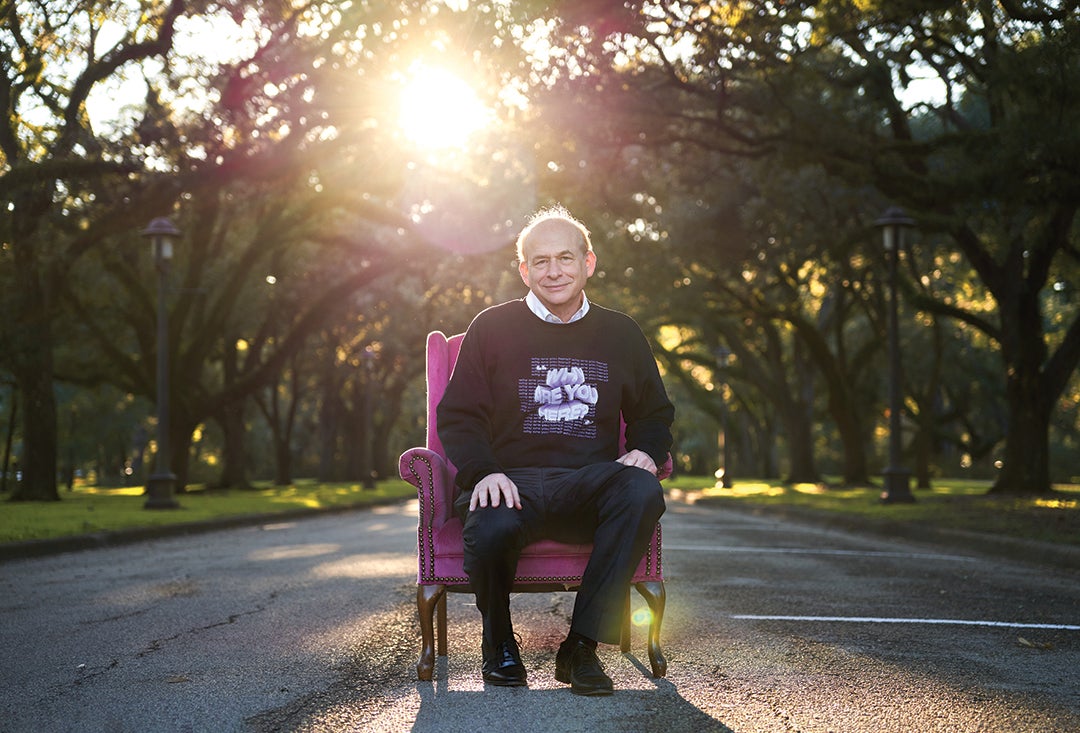
“Even as a comparatively small university, I think what we’ve shown the city is that we are going to be a positive force for Houston, and we’re committed to Houston,” Leebron said. “It’s not just a benefit for Rice to be in Houston, or an incidental fact of our history. It’s a core opportunity and commitment.”
When devising Rice’s most recent strategic plan — the Vision for the Second Century, Second Decade — Leebron felt it was time for Rice to commit to not only engage with Houston, but to try to empower the city.
Before the Ion project was developed, Leebron contacted Greater Houston Partnership President and CEO Bob Harvey about the city’s attempts to land Amazon’s latest headquarters. Once Harvey signed a nondisclosure agreement, Leebron confided that not only did Rice own the swath of Midtown land where Houston’s historic Sears store sat, but that Sears was vacating and Rice would make it available “if it helped the city in the Amazon bid.”
When Amazon went another direction, Leebron kept working with local business leaders and Mayor Sylvester Turner to figure out how this land could help Houston. Those discussions ultimately led to the Ion’s creation, and to Leebron’s decision that the new innovation hub wouldn’t have a Rice flag flying from its rooftop.
“We said when we started working on the Ion project that this would not be the Rice Ion, it would be the Ion for the city of Houston,” Leebron said.
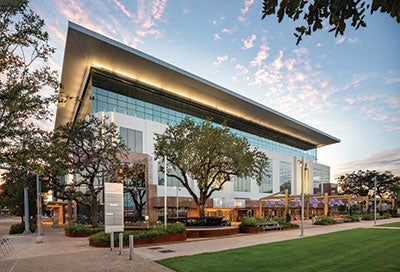
Expanding Opportunities
Leebron also knew Rice’s light could shine brighter outside the school’s historic southern sphere of influence, and Rice’s heightened focus on research during the Leebron years absolutely aided that effort. “We dramatically expanded our research into new and exciting areas from quantum sciences and synthetic biology to global health and urban resiliency. Research in these areas have the potential to be catalytic game changers for all of our futures,” said Shamoo.
Leebron’s creation of two new positions in his administration — dean of undergraduates and dean of graduate and postdoctoral studies — allowed Rice to more sharply focus on the needs of each group of students. Rice also boosted its visibility during Leebron’s presidency by investing in a wider breadth of opportunities for students, from launching the Doerr Institute for New Leaders and the Liu Idea Lab for Innovation and Entrepreneurship to adding more ways for students to get involved with the Center for Civic Leadership and the James A. Baker III Institute for Public Policy, as well as creating a minor and major in business.
These expanded opportunities included a concerted focus on digital education through the Rice Online initiative, allowing the school’s virtual offerings to grow dramatically. In 2012, five massive open online courses launched the project. By 2022, Rice’s digital options had exploded; in addition to four fully online master’s programs and a robust catalog of digital class offerings for full-time Rice students, Rice now offers over 70 online courses open to the general public. Over 2.2 million individuals have enrolled in Rice’s open online courses, over half of whom are international scholars.
Hello, World
Those who follow Rice’s leading couple closely know the full extent of how much Sun has contributed to the city during her time as Rice’s first lady. She’s served on countless nonprofit boards, including those of the United Way and Texas Children’s Hospital, and is now chair of the Asia Society Texas Center. She has been a beaming ambassador for Rice around the world even while serving of counsel to the Houston law firm Yetter and Coleman LLP.
“I didn’t realize how welcoming Houston was — the people here are just incredible,” Sun said. “They don’t really care where you’re from or what your parents do. They care about you. If you want to get involved in the community, they welcome you with open arms.”
Even as a comparatively small university, I think what we’ve shown the city is that we are going to be a positive force for Houston, and we’re committed to Houston. It’s not just a benefit for Rice to be in Houston, or an incidental fact of our history. It’s a core opportunity and commitment.
“Ping is a great asset, except for the fact that once people meet Ping, they have little desire to interact with me,” Leebron joked. “She’s such an outgoing person, a giving person … she’s just completely committed to helping assure the success of the university.”
Due in no small part to Leebron and Sun’s efforts, Rice has played a key role in Houston’s growing prominence on the national and international stages. Sun has also been an invaluable resource in Rice’s efforts to expand its reach internationally, particularly in her native China.
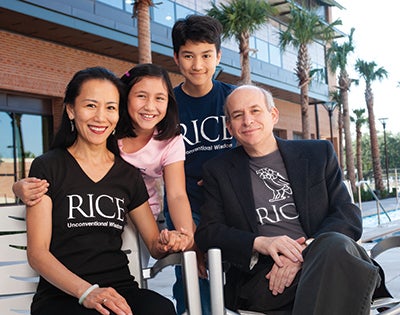
“When we hosted the convocation of Chinese universities with the vice premier of China on the Rice campus, I think that signaled in some ways a change in visibility,” Leebron said. Leebron also pointed to the successful collaborations between Rice and our Latin American neighbors as pivotal points of pride.
Some of Rice’s most consequential global partnerships during Leebron’s presidency have come to life thanks to the engagement of faculty in Africa, Brazil, China, France, India and elsewhere, supported by a new position Leebron created, a vice president for international strategy. It was also important to build programs and faculty, as exemplified by the Chao Center for Asian Studies, a massive enlargement of faculty engaged with Latin America, and most recently the Center for African and African American studies.
Leebron viewed strengthening Rice’s international connections and research collaborations while recruiting more international students as key ways to recommit the university to Lovett’s global ambitions for the school. “My whole life has been kind of internationally oriented,” Leebron shared, mentioning his international human rights and international law background and his many sojourns abroad over the years beginning with a Boy Scouts expedition at the age of 13. “So helping build that international presence, and visiting universities and university leaders around the world … it’s really been rewarding.”
In tandem, the Leebron administration’s efforts to boost Rice’s standing locally, nationally and internationally paved the way for Rice to grow its student body while making admissions even more selective than ever before, no small feat for any school. During Leebron’s presidency, the number of undergraduate applications to Rice ballooned from 8,100 for the class entering in 2004 to nearly 30,000 for the class entering in 2021. During that same time frame, Rice’s admit rate plummeted from 22% to 9%, putting Rice squarely among the most selective universities in the world.
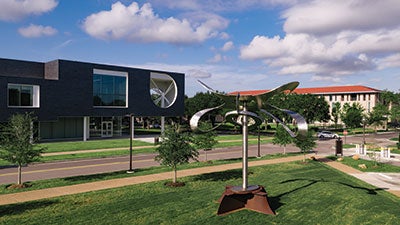
A Heart for the Arts
One of the most striking manifestations of Leebron’s vision for Rice is “Twilight Epiphany,” the monumental James Turrell Skyspace at the Suzanne Deal Booth Centennial Pavilion, made possible by Suzanne Deal Booth ’77, trustee emerita and generous arts patron.
Completed in 2012, the piece that transforms Houston sunrises and sunsets into dazzling lightscapes next to the Shepherd School of Music is a personal favorite of Leebron’s. “I love it,” Leebron said, “because it is also a statement about the aspirations of the university exceeding our scale and size.”
Leebron’s presidency has also been marked by the dramatic expansion of public art across campus. Beginning in 2008 with a universitywide initiative, Rice embarked on a robust public art program with thoughtful additions of sculptures, installations and more to light a spark in the minds of Rice scholars while making campus a more welcoming place for visitors. Rice now has approximately 30 major pieces of public art displayed around campus.
If you look at the legacy that he has left around the arts, it’s both deep and meaningful. [He knows] the arts are an essential part of a 21st-century education.

Rice further embraced the arts in 2017 with the founding of the Moody Center for the Arts, where visitors can experience an assortment of installations, exhibits and performances. Just as crucial to the Moody Center’s mission are the opportunities it’s provided for Rice’s student body, from maker spaces where Owls can create to their hearts’ content to ample programming focused on engaging students with art in all its shapes.
“If you look at the legacy that he has left around the arts, it’s both deep and meaningful,” said Alison Weaver, the Moody Center’s executive director, who was recruited by Leebron from New York City’s Guggenheim Museum. “[He knows] the arts are an essential part of a 21st-century education,” she said. Other signs of the university’s heightened focus on the arts, said Weaver, are Rice’s art history Ph.D. program, the recently opened Brockman Hall for Opera, the soon-to-be-built Sarofim Hall for Visual and Dramatic Arts, and plans for intimate theaters in both the new Moody Center for Student Life and Opportunity and Sarofim Hall.
“It’s a statement about who we are, a statement about the scope and values of the university,” Leebron said, fulfilling the last bit of Lovett’s “LETTERS, SCIENCE, ART” motto adorning Rice’s crest.
A Public Health Crisis
Leebron planned several years ago to step down from Rice’s presidency in 2022, but he obviously couldn’t have predicted that his presidency’s final chapter would be measured in significant part by Rice’s response to the coronavirus pandemic.
In terms of that response, Leebron said, “I’m most proud of our students. They have overwhelmingly behaved in such a responsible way,” which he chalked up to their buy-in toward perpetuating Rice’s culture of care and their strong desire to be on campus.
He also praised Rice’s Crisis Management Team and the Crisis Management Advisory Committee (CMAC) for the university’s successful navigation of the many twists and turns of the pandemic. After quickly pivoting to virtual instruction, Rice invested in massive outdoor tents to allow for socially distanced classes and outfitted Rice classrooms with the technology needed for simultaneous online and in-person instruction. Leebron and his team also oversaw Rice’s implementation of one of the most comprehensive coronavirus surveillance testing programs in the country, all work that drew national attention for the university’s proactive leadership.
Rice was able to keep COVID-19 cases dramatically lower than many peer institutions throughout the 2020–21 school year and the first half of the 2021–22 school year before the omicron variant emerged. Leebron credited the crisis team’s commitment to trust the data and never hesitate to quickly shift strategies.
“I tell people the key decision we made was to adopt the mantra of flexible, nimble and adaptable,” Leebron said. “And I think the second element was to say we will be guided by science, and we would keep the campus operational to the maximum extent that we could in a safe way.
“That resulted in us carving out a relatively unique position that won a lot of support internally and externally,” he continued, “really emphasizing the importance of being open and being willing to shift back and forth.”
Listen-First Leadership
From the beginning, Leebron knew he wanted to help harness and amplify Rice’s lively student spirit. Bill McKeon, president and CEO of the Texas Medical Center, recounted how Leebron was always energized by his engagement — and occasional tussles — with Rice’s student body.
“I think that’s what he’s loved the most about being president of the university is the interaction with the students, the way in which they looked at the world,” McKeon said. “And that would constantly keep him fresh with perspectives … he would just have a grin on his face: ‘Guess what they’re doing now?’ or ‘This could only happen at Rice.’”
Throughout his presidency, Leebron actively sought out those interactions. The sight of him and Sun walking through campus together became a near everyday occurrence, and the school’s first couple rarely turned down the chance to speak with students when their paths would cross.
Leebron said he’ll certainly miss the day-to-day interactions with students, and “the comfort people feel approaching me and engaging with me, just saying, ‘Hey, Leebs!’ or ‘Hey, Leebron!’” He’ll even miss the creative “jacks” students have pulled over the years, from filling up their house’s yard with pink flamingos and servery chairs to “the spoofing of an email, which I was pretty irritated at,” he said with a chuckle, “that suggested we were going to close the Brown School of Engineering.
“I think one of the really special things about being president at Rice is the expectation that you are available and approachable, but then also the joy you get from a lot of those direct interactions with students,” Leebron said.
I think that’s what he’s loved the most about being president of the university is the interaction with the students, the way in which they looked at the world. And that would constantly keep him fresh with perspectives.

Michelle Fokam ’20, a former Rice track athlete who served as Leebron’s presidential intern, saw firsthand how much he valued those interactions, even in response to heavier issues. “He tries his hardest, all the time, to make a welcoming and opening space for all students.” Fokam and former Student Association President Justin Onwenu ’18 highlighted Leebron’s commitment to making Rice a more diverse, welcoming place, his approach to sensitive topics like social belongingness for students of color and underrepresented groups, and his work preserving Rice’s status as a place where ideas can be discussed freely and every student feels safe.
“There were conversations about sexual assault policy, free speech, how do we make Rice a more inclusive place for people given how diverse Rice is racially and ethnically. … Immigration was certainly an issue that in Texas he as an institutional leader had to deal with and had to navigate,” Onwenu said.
From speaking out forcefully about the unclear status of many immigrant students when former President Donald Trump tried to end the Deferred Action for Childhood Arrivals program to his unequivocal remarks condemning bigoted mass shootings against Muslims in New Zealand and Latinos in El Paso, Leebron earned a reputation for using his platform to lift up the concerns of students.
Fokam worked with Leebron in 2020 after a group of Black students proposed a list of actions to improve the Black experience at Rice, including the removal of the Founder’s Memorial statue.
When Leebron met with students to address these issues, Fokam was struck by his open-minded, thoughtful approach. “President Leebron said, ‘We’re having this meeting to listen.’ I remember that specifically. He said, ‘I’m not going to talk too much, I don’t want to say much whatsoever.’”
Leebron echoed that ethos when asked about the Founder’s Memorial controversy. “Leadership is about listening, listening and listening,” he said. “People need to have a sense of being listened to, and you need to learn from people through listening and have your thinking honed and corrected in various ways.
“I think the statue issue has been very difficult, often because people start with their conclusions rather than their reasons,” Leebron continued. “Having a process that requires people to articulate what their thinking is, to work through history and debate to make reasoned and calm arguments about things. And I think if we all try to listen to each other, maybe we can find solutions that address a wide range of concerns.”
In June 2019, Leebron working with faculty created the Task Force on Slavery, Segregation and Racial Injustice to unflinchingly examine Rice’s connections to the slave trade and history of racial inequity. Its investigation painted a more troubling picture of William Marsh Rice’s entanglement with the slave trade than was previously known; the group would eventually recommend that Rice’s Academic Quadrangle “needs bold change,” which helped inform the Board of Trustees’ decision in January 2022 to relocate the statue away from the center of the quad.
“We have to be thoughtful,” Leebron said, “and when we deal with these very difficult issues about justice and equity and history, we have to recognize that there are a range of ways to think about these problems. We have to talk to each other and learn from each other.”
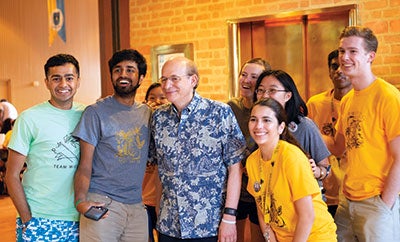
What’s Next?
Come June, Leebron and Sun are looking forward to what he calls his “26-year-delayed sabbatical.” He is most eager “to intellectually recharge, to read, to reacquaint myself with some areas of the law and really have the freedom to try to build my intellectual capacity on the issues that I’m most passionate about.
“And then, maybe I’ll come back to Rice after the sabbatical and teach in some of those areas,” he shared. “Our Rice undergraduates are terrific in law courses.” After stepping down, Leebron said he’s interested in finding ways to be more vocal than he felt would be appropriate as a university president on certain topics.
“Right now, I’m looking forward to exploring opportunities where you could be a bit more opinionated about some things,” Leebron said. “I think what’s worked for me at Rice is that some things I’m really passionate about are integral to the university’s success. Those include building a diverse community, building an international community, freedom of speech and expression.” Leebron also brought up his work in human rights law and his concern about democracy’s future.
“Those are deep, personal commitments,” he continued, “but I’m also limited in the ways in which I can engage in those things, so perhaps I’ll find a way to be more engaged.”
After he first self-effacingly deflected on how he hopes his time leading Rice will be remembered, Leebron ultimately settled on a response. Choosing his words carefully, he said, “I think I would like it to be remembered as a time that the university made great strides toward achieving its highest aspirations while remaining true to its core values and positive culture.”
Those who have watched his presidency closely know that Rice’s Leebron era will be remembered as a time of careful planning and reflection backed by transformative action. Risks were taken, but Leebron knew if Rice didn’t swing big, it never would have achieved half of the tremendous progress made over the past 18 years.
“Rice has become an incredibly important part of my life,” Leebron said.
Sun concurred: “I think Rice has definitely changed him for the better and vice versa.”
Unlike most captains, Leebron was the force moving the water which made that forward momentum possible.
“He wasn’t swept along with the tides,” said Parker. “He generated that wave. He created that wave, and he shaped it and knew where he wanted it to go.”
